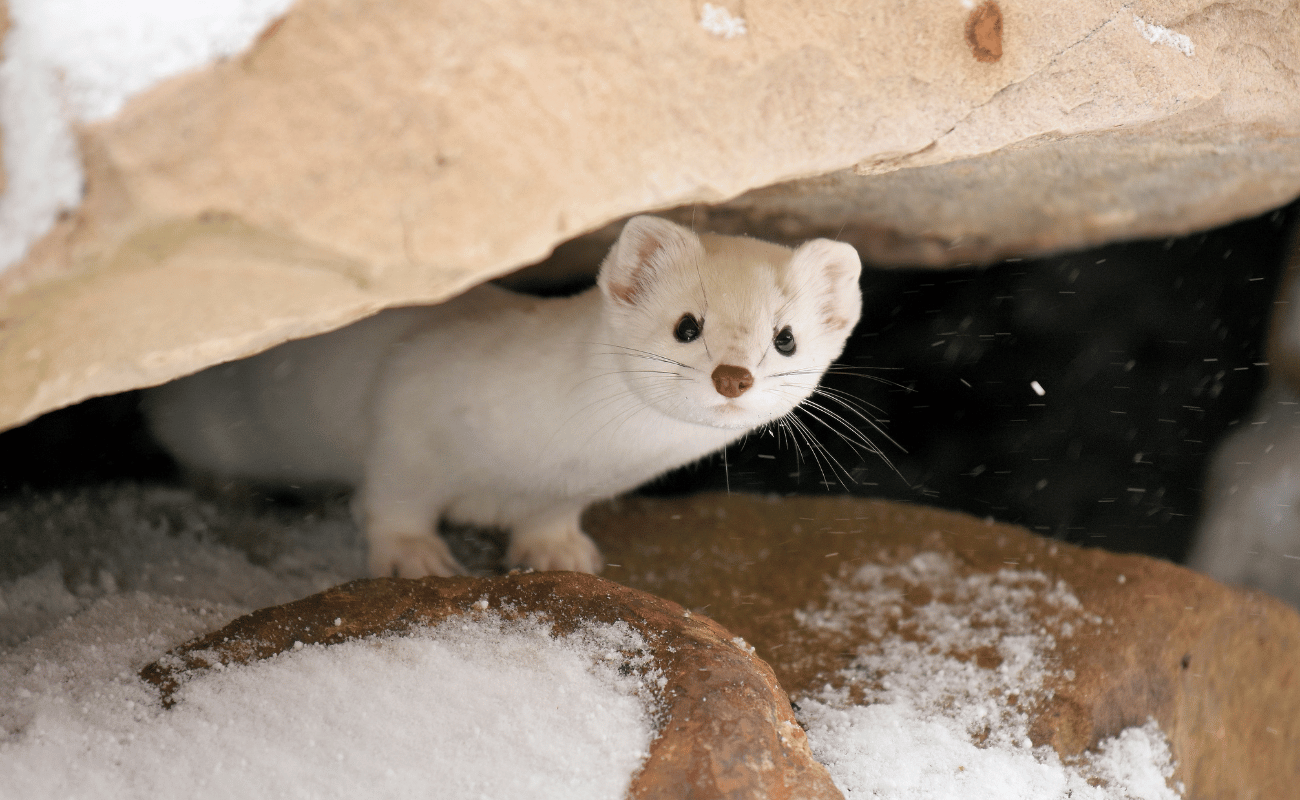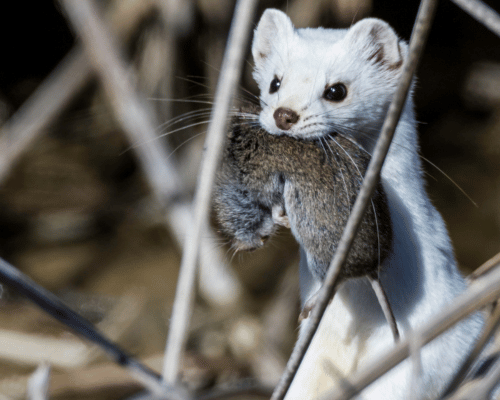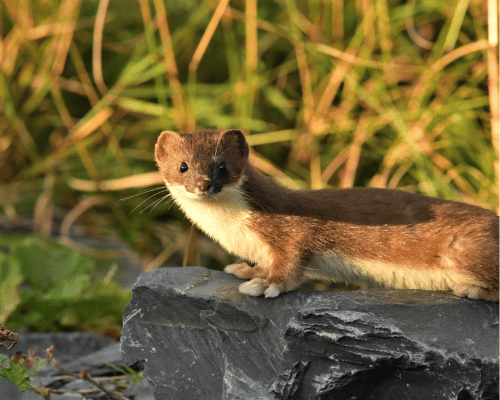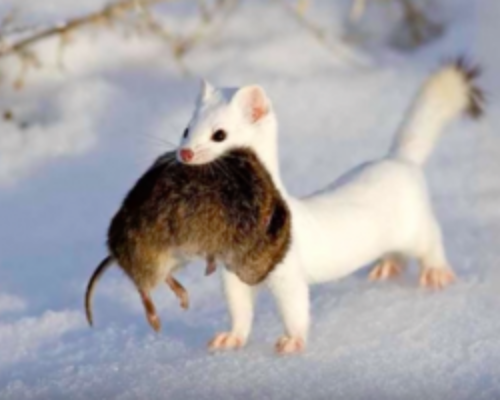Ermine vs Weasel: Spot the Difference!

Have you ever ventured into the breathtaking landscapes of the Grand Tetons and caught a glimpse of a swift and elusive furry creature? It might have been an ermine or a weasel! These small mammals often leave people puzzled due to their similarities. Today, we’ll embark on an exciting journey to unravel the secrets of the ermine family and help you differentiate between an ermine and a weasel. So, get ready to explore the fascinating world of ermine weasels and discover what makes them unique in the ermine vs weasel debate!
The ermine family, also known as mustelids, consists of various species, including the ermine, long-tailed weasel, and short-tailed weasel. These agile creatures are known for their slender bodies, short legs, and distinctive fur patterns. Their fur changes color depending on the season, providing excellent camouflage in their natural habitats.



5 Key Characteristics of Ermines
To help you identify an ermine in the wild, here are five key characteristics to look out for:
Understanding Ermine Size
Ermines are among the smallest members of the mustelid family. On average, they measure around 7-13 inches in length, with a tail adding an extra 2-5 inches. Despite their small size, ermines possess incredible agility and speed, making them formidable hunters.
Ermine vs. Weasel: Spot the Difference!
So, what sets an ermine apart from a weasel? While both belong to the same family, there are some distinct characteristics that differentiate them. Ermines, also called stoats, undergo a seasonal coat change. During the summer, their fur is brown with a white underbelly, whereas in winter, it turns completely white, except for the tip of their tail, which remains black. Weasels, on the other hand, have a more consistent coat color throughout the year, usually reddish-brown or brown.
The Life of an Ermine
Ermines lead fascinating lives in the wild. They are primarily solitary creatures, coming together only during the breeding season. They construct dens in underground burrows or repurpose abandoned burrows made by other animals. Ermines are also known for their exceptional climbing abilities, enabling them to pursue prey in trees.
Habitat and Distribution
Ermines are found across the northern parts of Europe, Asia, and North America. They thrive in various habitats, including forests, grasslands, and tundra. The Grand Tetons, with its diverse ecosystem, provides a suitable home for these elusive creatures.
Ermine Weasel: The Hunter
Ermines are skilled hunters, thanks to their excellent sense of smell, keen eyesight, and lightning-fast reflexes. Their diet primarily consists of small mammals such as mice, voles, and rabbits. With their slender bodies and agile movements, ermines can chase their prey through tight spaces, making them formidable predators.
Adapting to Seasons: Ermine in Winter
As winter sets in, ermines undergo a remarkable transformation. Their fur changes from brown to pristine white, acting as a natural camouflage in snowy landscapes. This adaptation allows them to blend seamlessly with their surroundings, both as a predator and to avoid becoming prey themselves.
Unique Adaptations of Ermine
Apart from their seasonal coat change, ermines possess several other unique adaptations that help them thrive in their environments. These adaptations include:
- Semi-Aquatic Abilities: Ermines are excellent swimmers, capable of diving underwater to catch fish or escape predators.
- Longevity: In the wild, ermines have an average lifespan of 3-5 years, although some individuals can live up to 10 years.
- Versatile Diet: Ermines are opportunistic feeders, adapting their diet to the availability of prey in their habitat.
- Winter Survival Strategies: To survive harsh winters, ermines actively hoard food and create multiple dens for shelter.
Fascinating Ermine Myths and Folklore
Throughout history, ermines have captivated human imagination, leading to the creation of myths and folklore. In medieval times, ermine fur was highly prized and associated with nobility. It was believed that ermines would rather face death than soil their pure white fur, making them a symbol of purity and honor.
FAQs About Ermines and Weasels
Q1: Do ermines and weasels belong to the same family? Yes, both ermines and weasels belong to the mustelid family, along with other members like badgers and otters.
Q2: Are ermines and weasels dangerous to humans? No, ermines and weasels are not dangerous to humans. They are shy creatures and typically avoid human interaction.
Q3: Can ermines swim? Absolutely! Ermines are excellent swimmers and can dive underwater to catch fish or evade predators.
Q4: Do ermines hibernate during winter? Ermines do not hibernate. Instead, they remain active throughout the year, adapting to the changing seasons.
Q5: Are ermines endangered? Ermines are not currently classified as endangered. However, like many wildlife species, their populations face threats due to habitat loss and climate change.
As we conclude our journey into the world of ermine weasels, we hope you’ve gained a newfound appreciation for these remarkable creatures. Remember, the next time you encounter a swift and agile furry friend in the Grand Tetons, you’ll be able to confidently identify whether it’s an ermine or a weasel. Happy exploring!





[…] Ermine, scientifically known as Mustela erminea, are a species of mustelid that exhibits a complex dichotomy in its ecological role. While often characterized as small and unassuming weasels, these creatures embody a predatory prowess that defies their diminutive stature. The ermine’s sleek, elongated body, adapted to its environment in the Northern Hemisphere, allows it to pursue prey with agility and stealth. […]